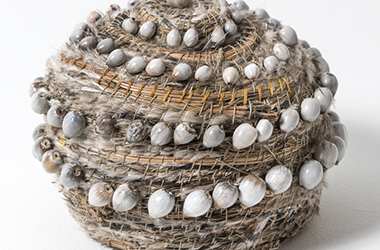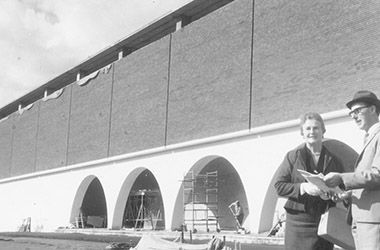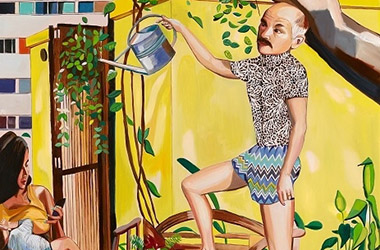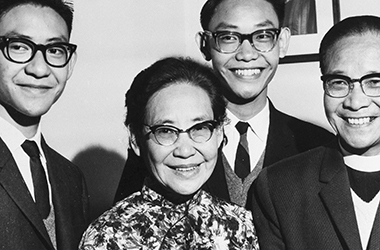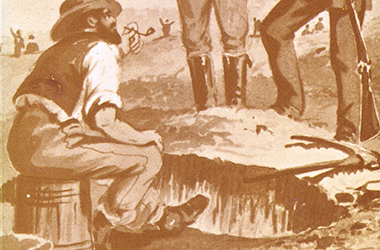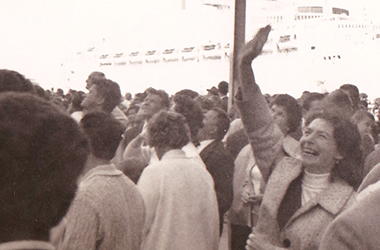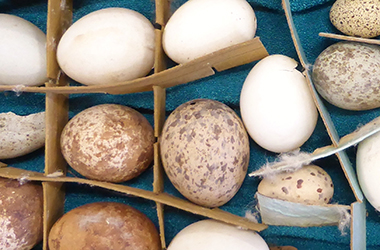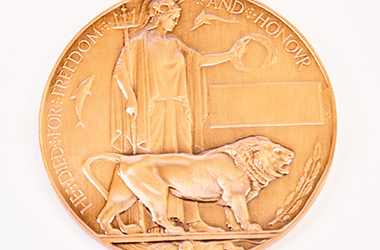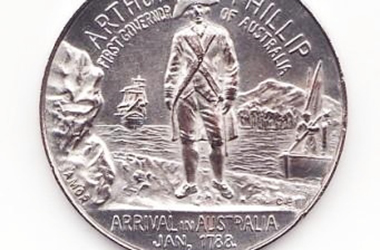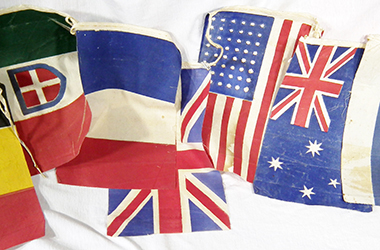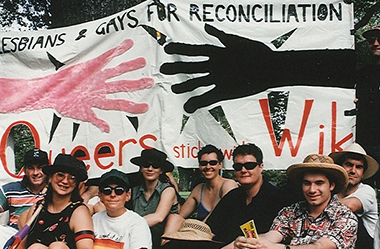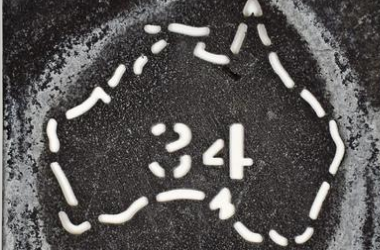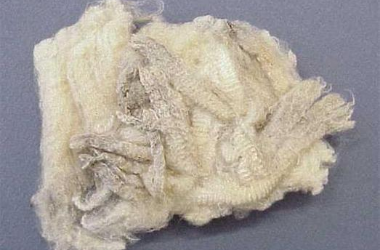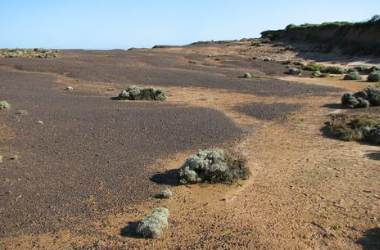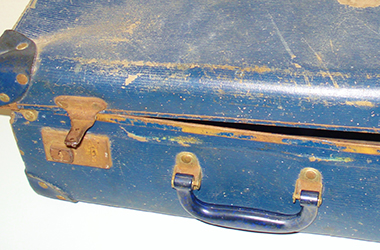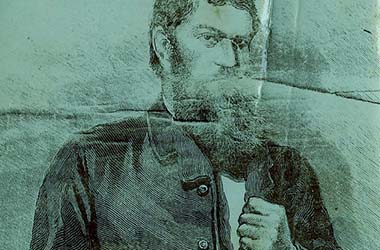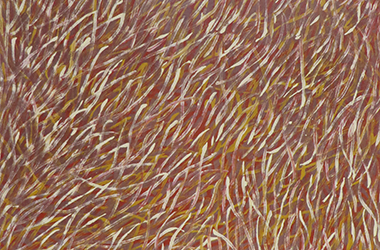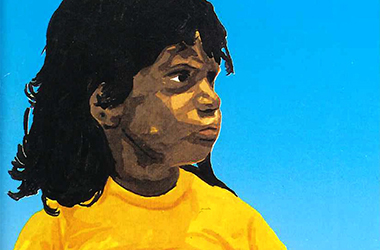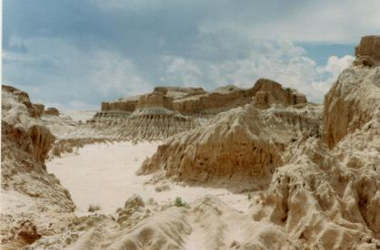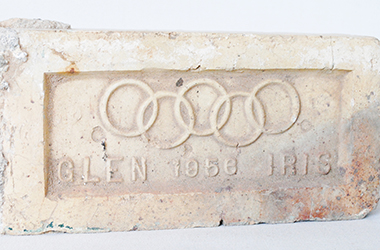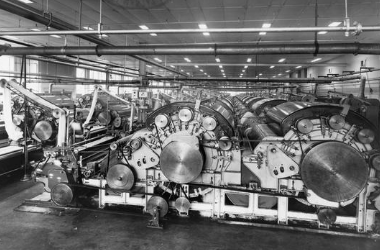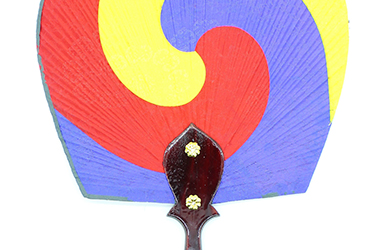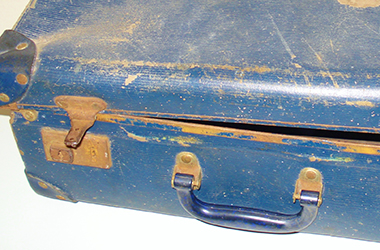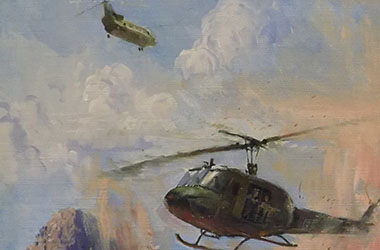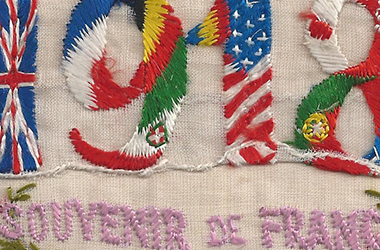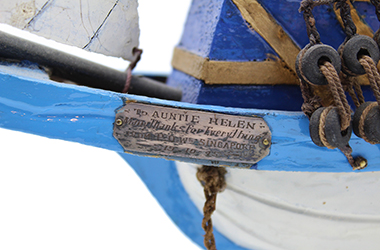Browse stories
-

Melbourne's Homes
These house plans from the late 19th and early 20th Centuries, give us an indication of how those with the means to build larger houses lived.
Servant's quarters, groom's rooms, sculleries, stables, parlours and children's areas give us clues to social attitudes, relationships to children and employees, social mores and living conditions.
-

Restoring St Nicholas
St Nicholas church in Humffray St, Ballarat East, was built in 1867. Originally named the Bible Christian Church, it was built by Cornish miners in the evenings and weekends after they had returned from their work at the diggings.
Like most buildings of its time it was built to last, constructed of solid brick with lime mortar. By the 1970s, the mortar was crumbling and the church community of the time re-mortared it with cement, a process we now know was incorrect for buildings of its age. The cement mortar, combined with rising damp, caused salt attack in many of the original bricks and the building literally began to crumble.
In 2009 the Greek Orthodox community of St Nicholas approached the City of Ballarat, Heritage Victoria and the trade school at the University of Ballarat to form a unique partnership to restore the church. This project allowed young apprentices to learn traditional trade skills and practice the technique of mixing and using lime mortar. In the process, the humble church has had its life extended, and the Greek community have a religious and cultural centre they can use for generations to come.
-

Rippon Lea Estate
"Do you remember the garden in which you grew up, or the part the backyard played in your family life? Imagine if you had actually grown up in one of Australia's finest gardens.
Created in the English-landscape tradition which traces its roots back to Capability Brown and Humphry Repton, Rippon Lea is one of Australia's most important historic homes, exemplifying the lifestyle of wealthy families living in 19th and 20th century Australian cities. Although its architecture and that of its outbuildings is impressive, it is the mansion’s gardens, which are truly remarkable, both for their landscape qualities and because they have survived many threats and changes in the past 130 years.
Today, the amenities offered by a typical garden are still greatly valued: a safe place for children to play, somewhere to dry the washing, a plot for vegetables and a flower garden that adds colour and produces blooms for the home. Today as then, the scale differs but the experience of owning a garden - with its balance of utility and ornament - is essentially the same.
The National Trust of Australia (Victoria) now runs Rippon Lea as a museum, conserving the architecture and the landscape, and presenting the social history of the owners and their servants. Visitors to Rippon Lea enter a mansion preserved as the Jones family lived in it after their 1938 modernisation. In the pleasure garden the Sargood era is evoked by the staging of a range of performing arts events including opera, theatre, chamber music and outdoor activities."
The text above has been abstracted from an essay Solid Joys and Lasting Treasure: families and gardens written by Richard Heathcote for the publication The Australian Family: Images and Essays. The entire text of the essay is available as part of this story.
This story is part of The Australian Family project, which involved 20 Victorian museums and galleries. The full series of essays and images are available in The Australian Family: Images and Essays published by Scribe Publications, Melbourne 1998, edited by Anna Epstein. The book comprises specially commissioned and carefully researched essays with accompanying artworks and illustrations from each participating institution.
-

St Paul's Cathedral
Refusing to set foot in the colony, the eminent Gothic Revivalist architect William Butterfield resorted to sending extremely detailed architectural drawings and plans of St Paul's Cathedral to Australia.
He even produced life-size drawings of columns, window tracery and other features, to ensure the antipodeans could get nothing wrong.
In the end however, he was defeated by distance, and St Paul's was completed by the Australian firm Reed, Henderson and Smart, and later, in the 1930s, the towers he designed (but were not built at the time) were shafted for a new design by Australian architect John Barr.
-

William Buckley
After convict William Buckley’s escape from a Victorian settlement he was discovered by the Wathaurang people who thought this pale, 198cm giant carrying a spear was the ghost of one of their leaders.
Buckley had arrived at Port Phillip from England in 1803 with about 300 soldiers, settlers and convicts after being sentenced to transportation for life. Before the Port Phillip and Sullivan Bay (Victoria’s first official European settlement) settlement was abandoned, Buckley escaped. He wandered alone for weeks before he was befriended by the Wathaurang people.
Over the next 32 years Buckley lived with the Wathaurang, learnt their language and customs, married and had a daughter. In 1835 he finally emerged to meet Batman’s colonising party and tried to work as an intermediary between settlers and aborigines, but felt he wasn’t trusted by either.
His name lives on in Australian slang with the ironic saying “you’ve got Buckley’s chance” or “Buckley’s hope”.
Further material can be found at the State Library of Victoria's Ergo site:-
William Buckley's Escape
Buckley and the Aborigines
Buckley's return to European life
-

100 Years of Flinders Street Station
Flinders Street Station: icon, meeting place, central to millions of city commuters. The building itself was the result an architectural competition held in 1902, and Mary Lewis, librarian, introduces us to the original winning entry, held at State Library of Victoria.
Explore the changing, and unchanging, face of Melbourne's streetscape with images of Flinders St, from photographs of the late eighteenth century to the works of art that Melbourne's famous railway station has inspired.
In 2010, Flinders Street Station celebrated its 100th birthday.
-
 Elizabeth Downes
Elizabeth DownesThe Unsuspected Slums
Campaigner Frederick Oswald Barnett recorded the poverty facing many in the Melbourne slums of the 1930s.
“All the houses face back-yards…The woman living in the first house…was so desperately poor that she resolved to save the maternity bonus, and so, with her last baby had neither anaesthetic nor doctor.”
So observed campaigner Frederick Oswald Barnett of the poverty facing many in the Melbourne slums of the 1930s. After touring these slums with Barnett, it’s said the Victorian Premier, Albert Dunstan, couldn’t sleep for days.
In 1936 Dunstan established the Slum Abolition Board, and Barnett became vice-chairman of the newly established Housing Commission of Victoria in 1938.
A Methodist and accountant, Barnett became determined to improve the situation for the poor, sick, elderly and unemployed after encountering a slum in the 1920s. He was an astute crusader who coordinated letter writing campaigns and lectured throughout Victoria using many of his own poignant and arresting photographs of the cramped and unsanitary housing conditions.
-

Viewbank: Unearthing a Colonial Homestead
Viewbank Homestead was one of the first grand homesteads built on the outskirts of Melbourne. Built around 1840, Viewbank was located near the junction of the Yarra and Plenty Rivers in Heidelberg.
The homestead was built in two phases. Originally a four room house, it was renovated and expanded in the 1850s and 1860s after it was acquired by wealthy squatter Dr Robert Martin.
Viewbank was destroyed by a professional demolition team in the early 1920s, long after the Martin family moved away from the area. By then, the house had fallen into disrepair and locals believed that it was haunted. For most of the 20th century, cattle grazed over the ruins and knowledge of the former grand homestead slipped from public knowledge until archaeologists returned to the site to unlock its secrets.
Between 1996 and 1999, Heritage Victoria conducted three excavations at the site with help from archaeologists from Melbourne, La Trobe and Flinders Universities, and more than 140 archaeology students and community members.
The archaeologists uncovered the stone foundations of the house and remnants of hand-made brick walls, fireplaces and other features. A range of artefacts were found during the excavation including children’s toys, coins, gaming tokens, thimbles and pins. A network of servant’s bells, fragments of marble fireplaces, and pieces of richly decorated plaster cornices reflect the affluence of the Martin family.
This story is made up of audio interviews with an archaeologist, an historian and a conservator. They discuss the Viewbank excavation, describe the artefacts found there and explain the process of their conservation at the Heritage Victoria conservation laboratory.
The Viewbank Homestead is listed on the Victorian Heritage Register. For more information on the Viewbank or other heritage sites visit The Victorian Heritage Database.
-

Wimmera Stories: The Dimboola Banner, communicating history
The first issue of the Dimboola Banner rolled off the press on 10 May 1879, printed by a Mr Henry Barnes and edited by his brother, William.
Many proprietors and editors have come and gone since then but today, more than 130 years later, the Banner is still published weekly, even though it’s now printed in Warracknabeal rather than in Dimboola itself.
Meanwhile, the former Dimboola offices of the Banner have been acquired by the Dimboola & District Historical Society and transformed into a Newspaper and Letterpress printing museum. The museum owns and operates a diverse collection of vintage presses, all in working condition.
Newspapers and printers have traditionally played a vital role in the life of country communities, and a long-time newspaper man comes to know most things there are to know about the life of their town and district. Joe Barry spent 54 years in the newspaper and printing business in Dimboola, which means he’s well qualified to impart a wealth of tales to visitors at the Dimboola Printing Museum.
The printing trade has seen many vast and radical technological transformations, particularly with the dawn and evolution of the current digital era. The Dimboola Printing Museum preserves a vast wealth of functioning relics from earlier eras of print technology, including letterpresses well over a century old in perfect working order.
The museum collection also includes a vast amount of loose type from the long-gone era of hand-set typography.
-

Wimmera Stories: Murtoa Stick Shed, Enduring Ingenuity
Colloquially known as the Stick Shed, the Marmalake Grain Store Wheat Storage Shed is the largest building in Murtoa, out on the Wimmera plains between Horsham and St Arnaud.
The Stick Shed is a type of grain storage facility built in Victoria during the early 1940s. The Marmalake / Murtoa Grain Store No.1 was built in 1941-42 during a wheat glut, to store wheat that could not be exported during World War II. It is the earliest & last remaining example of this particular grand Australian rural vernacular tradition.
The Stick Shed is 265 metres long, 60.5 metres wide and 19-20 metres high, supported by 560 unmilled mountain ash poles. Its vast gabled interior space and long rows of poles have been likened to the nave of a cathedral.
The Stick Shed demonstrates Australian ingenuity during a time of hardship, it was added to the Victorian Heritage Register in 1990.
Find more stories and photographs about the Stick Shed on the Way Back Then blog.
-

Wimmera Stories: Nhill Aeradio Station, Navigating Safely
The Nhill Aeradio Station was a part of a vital national network established in 1938 to provide critical communications and navigation support for an increasing amount of civil aircraft.
Situated at the half-way point of a direct air-route between Adelaide and Melbourne, Nhill was an ideal location for an aeradio station and was one of seventeen such facilities originally built across Australia and New Guinea by Amalgamated Wireless Australasia Ltd (AWA) under contract from the Commonwealth Government.
The Aeradio Station at Nhill operated until 1971, when a new VHF communication network at Mt William in the Grampians rendered it obsolete and the station was decommissioned.
The aeradio building survives today in remarkably original condition, and current work is being undertaken by the Nhill Aviation Heritage Centre group to restore the Aeradio Building and interpret its story as part of a local aviation museum.
-

Athol Shmith
Athol Shmith's career as a portrait, fashion and advertising photographer, spanning over 60 years, made him both a documenter and shaper of Melbourne style.
When Athol Shmith moved to a studio in Collins Street's 'Paris End' in 1939 to begin his career in fashion photography, his main problem was the lack of professional models.
Very few models existed in 1930s Melbourne due to the connotations associated with the profession. In order to make his mark, Shmith became inventive, recruiting suitable young women from Melbourne's most prominent families. By drawing on high society, he gave fashion photography an air of respectability, and by the 1940s, the model and photographer professions were firmly established.
As Melbourne's leading fashion photographer, Shmith spearheaded the introduction of the 'modern look' to local fashion, using clean and bold lines and arrangements combined with Hollywood Glamour.
-

Badger Bates
Badger Bates (William Brian Bates) was raised by his extended family and his grandmother Granny Moysey, with whom he travelled the country, learning about the language, history and culture of the Paakantji people of the Darling River, or Paaka.
When he was about 8 years old Granny Moysey started to teach him to carve emu eggs and make wooden artefacts in the traditional style, carving by ‘feeling through his fingers.’
Badger works in linoprint, wood, emu egg and stone carving, and metalwork, reflecting the motifs, landforms, animals, plants and stories of Paakantji land. His art is an extension of a living oral tradition, and in his work we find the wavy and geometric lines from the region’s wooden artefacts; places of ceremonial and mythological importance; depictions of traditional life such as hunting and gathering bush tucker; and stories about the ancestral spirits; as well as contemporary issues such as the degradation of his beloved Darling River.
-

Dame Nellie Melba
“...the voice, pure and limpid, with an adorable timbre and perfect accuracy, emerges with the greatest ease.” Arthur Pougin, in Le Ménestral (Paris), May 12, 1889.
Dame Nellie Melba (1861 – 1931), was Australia’s opera superstar, performing in the great opera houses of the world - the Paris Opera, La Scala, the Metropolitan Opera House, and the Royal Opera House, Covent Garden, where she became prima donna, returning season after season.
The extensive Melba Collection at the Victorian Arts Centre includes costumes, records, accessories, letters, programs, photographs, opera scores and other personal effects. Other holdings of interest include 78rpm disks at the State Library of Victoria.
-

Digital Storytelling
Digital Storytelling is a powerful form of media expression that enables individuals and communities to reclaim their personal cultures and stories while exploring their artistic creativity.
The Australian Centre for the Moving Image (ACMI) is Australia’s premier engine for screen and digital culture industries and assists in the creation and recording of hundreds of stories by individuals, community groups and organisations through its respected Digital Storytelling program, and ensures public access to the stories through exhibition.
Recording these stories has ensured many vital individual and community memories are preserved. The digital stories provide a personal voice that gives 'life' to issues that are often hard to personalise.
The ACMI Digital Storytelling program reflects its philosophy of drawing people closer to the moving image in all its forms and to foster interaction, understanding and a personal connection.
For more information on ACMI’s Digital Storytelling program, visit: Collections digital storytelling
-

Kylie's Costumes
From Neighbours character, Charlene, to international pop sensation, Kylie Minogue’s costumes chart her rise, her style, and her creative energy.
The Kylie Costume Collection at the Arts Centre, Melbourne, shows the range and development of Kylie's persona through costume, and her collaborations with international and national designers.
As Kylie donates her costumes to the Arts Centre directly, curators are able to keep an extensive, chronological and very complete material record of Kylie's career, across her tours, album cover shoots, music videos, and red carpet and special events.
-

Eugene von Guérard
Eugene von Guérard was born in Vienna in 1811. He was the son of the court painter to Emperor Franz Joseph 1 of Austria, Bernard von Guérard, and became a painter himself, studying under Johann Schirmer at the Academy in Düsseldorf.
He came to Australia to try his luck on the goldfields. Unsuccessful, he resumed his painting career in Melbourne in 1854, and by 1870 was appointed First Master of Painting at the National Gallery School, Melbourne and Curator of the National Gallery of Victoria. He returned to Europe in 1882.
His landscapes, remarkable for their detail, are much valued for the depiction of Australian and particularly, Victorian, landscapes of the mid-1800s.
-
 Malcolm McKinnon
Malcolm McKinnonJohn Teasdale – Chronicle of a Country Life
These little films from Victoria's Western Plains are about the actual and the everyday.
They have no hint of sensationalism in them. They are plain and utterly honest. They tell us about tractors and farming machinery. About fire and flood and snow. We glimpse Anzac Day and are touched by the irony of people remembering in a time and place few people remember or think about today. But there is no sentimentality in these films either. They are just plain good. - Martin Flanagan.
John Teasdale (1936 – 2004) was a farmer at Rupanyup in the Victorian Wimmera. He was also a keen and highly accomplished cinematographer, filming consistently for over 50 years to create a long-term record of working life on a family farm and of community life in a particular part of rural Victoria.
When television arrived in Australia in 1956, John successfully applied to the ABC to become a 'stringer' cameraman, shooting regional footage that was frequently included in state-wide news broadcasts and in segments produced particularly for regional viewers. John continued in this role for thirty years, until changing technology eventually made the role of 'regional stringers' obsolete.
The Teasdale film collection constitutes a nationally significant record of working and community life in a small Australian dry-land farming community, reflecting enormous changes in farming practices as well as transformations in the character and scale of community life in and around Rupanyup. At a time when many dry-land farming communities are actively reinventing themselves as their underlying social and economic structures change dramatically, John Teasdale’s films provide a critical point of reference and affirmation.
Artist and filmmaker Malcolm McKinnon, with the support of John Teasdale’s family, is undertaking ongoing work to interpret and celebrate this rich and resonant archive.
-

Lorraine Northey Connelly
Once a symbol of cultural survival, traditional crafts have in recent years become a means of reaffirming cultural identity.
In the hands of Waradgerie artist Lorraine Northey Connelly, this rich tradition undergoes further reinterpretation. She transforms woven string baskets and coolamons into contemporary colonial artefacts, using rustic materials, synthetic paint, ochre painted on sheets of corrugated iron, scrap metals and wire netting: expressive of a shared history and her own heritage of mixed cultures.
Over the past fourteen years Lorraine has been re-discovering her childhood environments, namely the mallee and riverine, acquiring a knowledge of local native and introduced plants and their cultural uses. Lorraine's personal interest in the protection of the environment and equality for all is represented in her art, through the use of recycled materials and symbols of reconciliation.
-

ManStyle: Men + Fashion
Charting a course between absolute restraint and ostentatious display ManStyle explores the extremes of masculine style and some of the most influential ideas that have pervaded menswear over the past three centuries.
ManStyle presents a broad survey of menswear from around 1740 to the present using examples from the NGV collection. Beginning in the eighteenth century with exquisite brocade and embroidered silk coats, the exhibition explores the evolution of the modern suit via the elegantly honed lines of the nineteenth century dandy, examining the rise of tailoring with its focus on perfect cut and fit.
In contemporary menswear design, new and traditional modes of dressing are continually merging to create new definitions of masculinity. From tradition to transformation: changes in proportion, shape and detail as well as material, colour and pattern, including the more radical influence of sportswear, sub-cultural attire and street wear; all have affected men’s fashion.
A range of men discuss their own personal fashion and style. Their responses were often frank, considered, funny or surprising, as each reflected on what they wear and the influences, experiences and observations that have shaped their clothing choices.
-

Paintings Porcelain and Photography
Geelong Gallery was established in 1896 by twelve passionate citizens who believed Victoria's second largest and fastest growing city deserved an art institution befitting an aspiring metropolis. Since then, Geelong Gallery has established a collection of some 6,000 items – significant amongst these items are their holdings of paintings, porcelain and photography.
The gallery’s collection of Australian painting tells the history of the region from colonial times to the early twentieth century. Eugene von Guerard’s View of Geelong provides a sweeping panorama of Geelong seen from a vantage point near the village of Ceres in the nearby Barrabool Hills in 1856. While Arthur Streeton’s painting Ocean blue, Lorne, one of the gallery’s most recent acquisitions, depicts a shimmering summery sky, a view through slender young gum trees and down to the pristine sand and aquamarine ocean below in the 1920’s.
Geelong Gallery has a large and specialised collection of British painted porcelain spanning 1750 – 1850. It is one of the most significant holdings in Australia and is part of a bequest by well-known local citizen Dorothy McAllister. A fine example is the 'Buckingham Palace' card tray by renowned manufacturer Worcester dating to the 1840’s.
The gallery’s photographic collection is very much of the twentieth century, but not without references to earlier times and other works in the collection. Polixeni Papapetrou’s photograph In the Wimmera 1864 #1 created in 2006 examines the narrative of the ‘lost child’ and refers to Frederick McCubbin’s late nineteenth century paintings of children ‘lost’ or at least wandering absent-mindedly through the Australian bush.
-

Restoring "Shearing the Rams"
John Payne and Michael Varcoe-Cocks, conservators at the National Gallery of Victoria, explain how the restoration process for 'Shearing the Rams' by Tom Roberts began, with an x-ray of the iconic painting.
-

SCOOT
Scoot is a location based game produced to explore mobile phone technology and as a playful way to engage with Melbourne’s key cultural institutions. Scoot was created by artist Debra Polson through the Queensland University of Technology and produced by ACMI in collaboration with various cultural partners.
The Australian Centre for the Moving Image (ACMI) is a world leading cultural institution dedicated to celebrating and exploring games. As the first cultural centre in the world to have a dedicated games lab space, ACMI has been involved in the development and research of location based games.
Such location-based gaming allows for the development of relationships between people and spaces. Participant awareness of Melbourne’s cultural resources increases as they feel more comfortable engaging in the history and identity of the city via its arts institutions.
Artist and academic Debra Polson currently lectures in the field of interaction design at the Queensland University of Technology and is a project leader at the Australasian CRC for Interaction Design (ACID). Debra has worked as an interface designer on interactive games and various other multimedia productions and continues to design location-based games.
Her research interests lie in new immersive forms of game play that blur the edges between the digital and physical realms with a particular focus on the community interactions that emerge from these experiences and the potential for new multi-modal forms of entertainment and education within those communities.
Currently researchers and artists have been experimenting with ways to apply new forms of mobile technologies combined with digital media to examine new ways for people to interact in both physical and virtual spaces. Debra Polson has been particularly interested in how effectively they enhance the relationships between location, participants and cultural activities.
-

Set and costume design
By exploring aspects of the J. C. Williamson Archive at the Arts Centre, and interviewing scenic artist Paul Kathner, we get a sense of the behind the scenes work involved in creating the visual effect of theatre.
Curator Margaret Marshall introduces us to a Williamson scenebook from the 1920s, and to costume designs from the late 19th and early 20th century, and Paul invites us to explore his craft and his career with major theatre companies for the past 50 years.
-

State Film Centre
Designed to collect and maintain a film library for general public consumption, the State Film Centre was established in 1946.
It became a leading cultural institution for not only the archiving of Australian and international cinematic works but in supporting the Victorian production industry, providing regional lending services and broadening audience reach through the use of mobile projection units.
With technological change, the Centre adapted to new media platforms and broadened its collections focus to include emerging filmmakers and student works. It evolved from a collection-based institution to a hub for screening and advocacy and increased its role as an invaluable education resource.
Into the 1990s work commenced on plans to establish the Australian Centre for the Moving Image as part of the Federation Square project and on January 1, 2002, the Australian Centre for the Moving Image was officially established by the Film Act 2001 (Victoria).
-

The Australian Environment
The landscape and environment of South Eastern Australia vary dramatically from season to season. The beauty and power of these changes, both physically and psychologically, have been depicted by a range of Australian artists featured in the Gippsland Art Gallery’s permanent collection.
The collection takes us on a journey through the landscape and, importantly, serves as a destination for current and future generations to experience the ways artists interpret the landscape and environment of South Eastern Australia.
Horizon by Andrew Browne is comprised of four panels which span eleven and a half metres. This significant work takes the audience on a journey from the natural world, through the man-made world and onto another, distant destination.
Tony Lloyd’s painting Tomorrow Follows Yesterday takes us on another type of journey. His landscape featuring snow-capped mountains immerses us in the artistic tradition of Romanticism while a jet-trail in the sky brings us rushing into the twenty-first century.
While world renowned local artist Annemieke Mein has created textile landscapes dotted with dragonflies and other creatures from the natural world. These large textile landscapes are based on her field studies in and around Gippsland.
Here you can view a selection of works from Gippsland Art Gallery’s significant collection that depict and interpret different states of the Australian environment. The video, featuring the gallery’s Director and Curator, provides further background and close ups of these striking works by Peter Booth, Mike Brown, Andrew Browne, Victor Majzner, Annemieke Mein and Tony Lloyd.
-

The Elliott Collection
Mildura Arts Centre was founded on one of Australia's most remarkable and generous bequests.
Senator 'R.D.' and Mrs Hilda Elliott's collection of mainly British and Australian art has provided Mildura Arts Centre with intriguing and significant works by such artists as William Orpen, Edgar Degas, Frederick McCubbin, Arthur Streeton, Glyn Philpot and Frank Brangwyn: artists, for the most part, from a world about to swamped by the tides of modernism and the avant-garde.
-

Textiles and Fibre Art
Established in 1968, Ararat Regional Art Gallery has a unique collection of textiles and fibre art dating from the 1970s, '80s and '90s through to now.
The gallery started collecting work in the 70’s arising from Australia’s growing craft movement – including glass and ceramics. A decision was later made to focus the collection on textiles to reflect the region’s historical association with fine merino wool production. The gallery now has over 1,200 items in its collection, with pivotal works by leading Australian and international artists working in fibre and textiles.
Textiles have been woven from fibre to create clothing and other items since prehistoric times. The 1960’s were a time of great change, with feminism entering the general lexicon and encouraging a questioning of the status quo. Initially aligned with 'women’s work', textiles have become a rich field for both male and female artists to examine gendered roles and social mores, as well as the boundaries of artistic practice.
Ararat Regional Art Gallery’s collection provides an invaluable history of textiles and fibre arts, and in doing so, it maps the influential role fibre and textiles have played in extending the boundaries both of visual art and social parameters.
Contemporary works featured in the gallery’s collection continue this tradition, with Lucas Grogan’s hand embroidered quilt offering a critique of contemporary culture.
Featured here are twenty representative works from the gallery’s textile and fibre art collection. Watch a video to learn about the history of Ararat Regional Art Gallery’s collection and see works by artists John Corbett (Australia), Olga de Amaral (Columbia), Tony Dyer (Australia), Kate Just (USA/Australia), Sebastian Di Mauro (Australia) and Yvonne Koolmatrie (Australia/Ngarrandjeri).
-

The Fashion Detective
The NGV’s fashion archive contains countless works about which we know little.
We don’t know who made them, who wore them, when or why, or indeed, what happened in them! For the curator, such works are endlessly intriguing; a form of ‘material evidence’ to examine and explicate.
In 2014, the NGV’s Fashion Detective exhibition took a selection of unattributed nineteenth century garments and accessories from the Australian fashion and textiles collection as the starting point for a series of investigations. Using forensics and fiction as alternate interpretative methods, the exhibition considered the detective work that curators and conservators do and where this can lead, as well as the role of storytelling in making visible the social life of clothes.
From fakes and forgeries to poisonous dyes, concealed clues and mysterious marks to missing persons, Fashion Detective was a series of ‘cases’ that each followed a different path of analysis.
Some relied on empirical study and science to reach conclusions, others were purposefully speculative - the inspired hypothesis of leading crime writers Garry Disher, Kerry Greenwood, Sulari Gentill and Lili Wilkinson.
A playful exhibition about modes of enquiry, Fashion Detective considered the different ways in which we can decode objects in order to reveal what is normally concealed, and challenged the visitor to reappraise what they see and what they know.
-

60s & 70s waves
Since the 1960s Australia has welcomed migrants from Asia, Africa, Oceania, the Middel East and South America.
Many migrated to flee from the ravages of war, hunger, religious persecution or political repressions in their home country. Others were seeking a new beginning, a brighter future or reunification with loved ones.
These stories produced through ACMI’s Digital Storytelling program share the personal experiences of migration and settlement and are a testimony to the cultural diversity of modern Australia.

